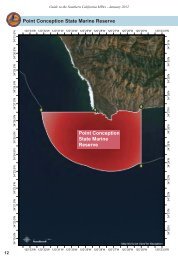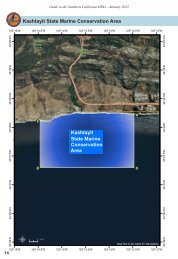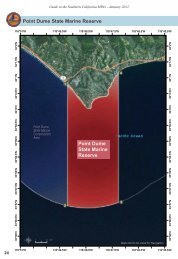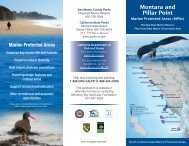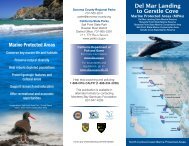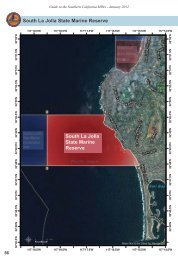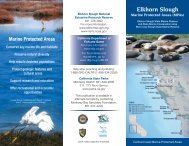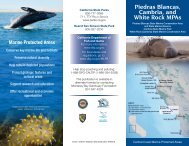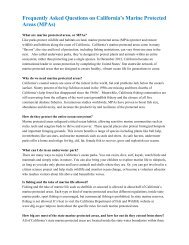Point Lobos
Point Lobos Brochure - California MPA Educational Resources
Point Lobos Brochure - California MPA Educational Resources
- No tags were found...
Create successful ePaper yourself
Turn your PDF publications into a flip-book with our unique Google optimized e-Paper software.
California State Parks<br />
Monterey District: 831-649-2836<br />
711, TTY Relay Service<br />
www.parks.ca.gov<br />
<strong>Point</strong> <strong>Lobos</strong> State<br />
Natural Reserve<br />
831-624-4909<br />
<strong>Point</strong> <strong>Lobos</strong><br />
Marine Protected Areas (MPAs)<br />
<strong>Point</strong> <strong>Lobos</strong> State Marine Conservation Area<br />
and State Marine Reserve<br />
Carmel Pinnacles State Marine Reserve<br />
Carmel Bay State Marine Conservation Area<br />
Marine Protected Areas<br />
Conserve key marine life and habitats<br />
Preserve natural diversity<br />
Help rebuild depleted populations<br />
Protect geologic features and<br />
cultural areas<br />
Support research and education<br />
Offer recreational and economic<br />
opportunities<br />
California Department of<br />
Fish and Game<br />
For more information:<br />
www.dfg.ca.gov<br />
For boundaries and<br />
regulations, go to:<br />
www.dfg.ca.gov/MLPA<br />
Help stop poaching and polluting:<br />
1-888-DFG-CALTIP (1-888-334-2258)<br />
This publication is available in<br />
alternate formats by contacting<br />
Monterey Bay Sanctuary Foundation:<br />
831-647-4209<br />
Image above: <strong>Point</strong> <strong>Lobos</strong> (Jay Spooner)<br />
below: hermit crab (Jerry Kirkhart)<br />
Cover: southern sea otters (Jerry Kirkhart)<br />
Central Coast Marine Protected Areas
om rocky shores to the depths of Monterey Canyon<br />
California Is Making a Difference<br />
by creating a statewide network of marine<br />
protected areas (MPAs). Marine protected<br />
areas are underwater places designed<br />
to protect key habitats and species by<br />
prohibiting or restricting the take of marine<br />
life. Just as the nation’s parks, forests and<br />
wilderness areas protect special places<br />
on land, California’s MPAs protect unique<br />
areas in the ocean. The California MPA<br />
network includes the many different types<br />
of habitats found along our coast, from<br />
sheltered estuaries and lush kelp forests to<br />
steep underwater canyons.<br />
Image above left: giant green anemone (Jerry Kirkhart)<br />
above right: diver silhouette (Jerry Loomis)<br />
<strong>Point</strong> <strong>Lobos</strong>: The Greatest Meeting<br />
of Land and Water<br />
<strong>Point</strong> <strong>Lobos</strong>, a crown jewel for California,<br />
teems with life. Its hiking trails offer vistas<br />
of sea-splashed cliffs, windswept Monterey<br />
cypress trees, and lush kelp beds where<br />
endangered sea otters frolic. Sleek harbor<br />
seals rest and give birth on the cove’s small<br />
beach. Sea lions congregate on rocks<br />
offshore. The place is so spectacular both<br />
above and below the water line that the<br />
state of California prohibits removal of any<br />
natural resources on land or in the water.<br />
Amazing Diversity of Life<br />
• Many species of fish live in the rocky<br />
tidepools, kelp forests, sandy bottoms<br />
and deep canyons off <strong>Point</strong> <strong>Lobos</strong>.<br />
Cabezon, vermillion rockfish and blue<br />
rockfish hide among the kelp, while<br />
mola mola may be found basking on the<br />
surface offshore. Goby and sculpin can<br />
be found darting amongst the tidepools.<br />
• Marine mammals such as sea otters, sea<br />
lions and harbor seals find shelter along<br />
the shore.<br />
• Invertebrates such as abalone are slowly<br />
rebounding with protection.<br />
• Over 300 species of birds can be found<br />
benefiting from the abundance of food<br />
and habitat afforded by protected land<br />
and seas.<br />
Recognized Throughout History<br />
<strong>Point</strong> <strong>Lobos</strong> has long been cherished.<br />
Native Rumsien harvested fish and<br />
shellfish long before European explorers<br />
arrived. From the 1850s to the 1930s,<br />
<strong>Point</strong> <strong>Lobos</strong> played host to a number<br />
of industries: fishing, whaling, a granite<br />
quarry, a coal port and a large abalone<br />
fishing operation. Today the area is<br />
recognized by nature enthusiasts who<br />
hike, photograph, kayak, SCUBA dive,<br />
snorkel and enjoy a “look but do NOT<br />
disturb” approach to wildlife.<br />
Hopkins’ rose nudibranch<br />
(Jerry Loomis)<br />
harbor seal (Steve Lonhart)<br />
strawberry anemone (Jerry Loomis)<br />
giant kelp (Jerry Loomis)<br />
copper rockfish (Chad King)<br />
brown pelican (Jerry Kirkhart)
California Marine Protected Areas<br />
The California statewide MPA network<br />
includes four different types that vary in their<br />
purpose and level of protection, ranging from<br />
limited to no take. The MPA designations are:<br />
State Marine Reserves: No damage or take of living marine resources, geologic or cultural resources is allowed.<br />
State Marine Parks: No commercial take of resources is allowed, but some recreational take may be allowed (restrictions vary).<br />
State Marine Conservation Areas: Some recreational and/or commercial take of marine resources may be allowed (restrictions vary).<br />
State Marine Recreational Management Areas: Restricts the take of living marine resources while allowing for waterfowl hunting to<br />
occur (restrictions vary).<br />
<strong>Point</strong> <strong>Lobos</strong> Marine Protected Areas<br />
kelp crab (Jerry Kirkhart)<br />
<strong>Point</strong> <strong>Lobos</strong> MPAs<br />
MPA<br />
<strong>Point</strong><br />
<strong>Lobos</strong><br />
SMCA<br />
<strong>Point</strong><br />
<strong>Lobos</strong><br />
SMR<br />
Carmel<br />
Pinnacles<br />
SMR<br />
Carmel<br />
Bay<br />
SMCA<br />
Recreational<br />
Uses<br />
No fishing except<br />
recreational and<br />
commercial take of<br />
salmon, albacore,<br />
and commercial take<br />
of spot prawn.<br />
No fishing; All take is<br />
prohibited.<br />
No fishing; All take is<br />
prohibited.<br />
Recreational fishing<br />
allowed.<br />
Regulations<br />
This document does not replace<br />
the official regulatory language<br />
found in California Code of<br />
Regulations, Title 14, Section 632,<br />
including commercial allowances<br />
and restrictions.<br />
• A fishing license is required for<br />
any fishing.<br />
• All existing take regulations still<br />
apply in addition to the ones<br />
listed above.<br />
• Unless otherwise stated, all<br />
non-consumptive recreational<br />
activities are allowed.




